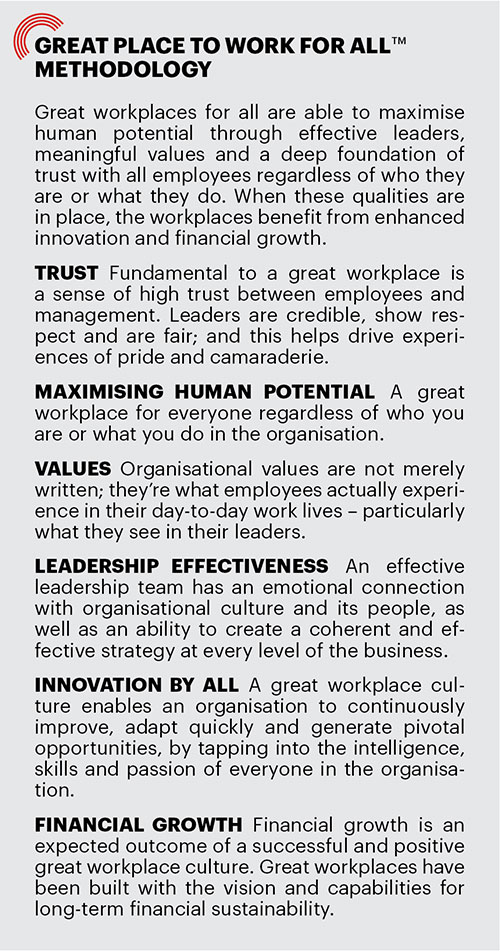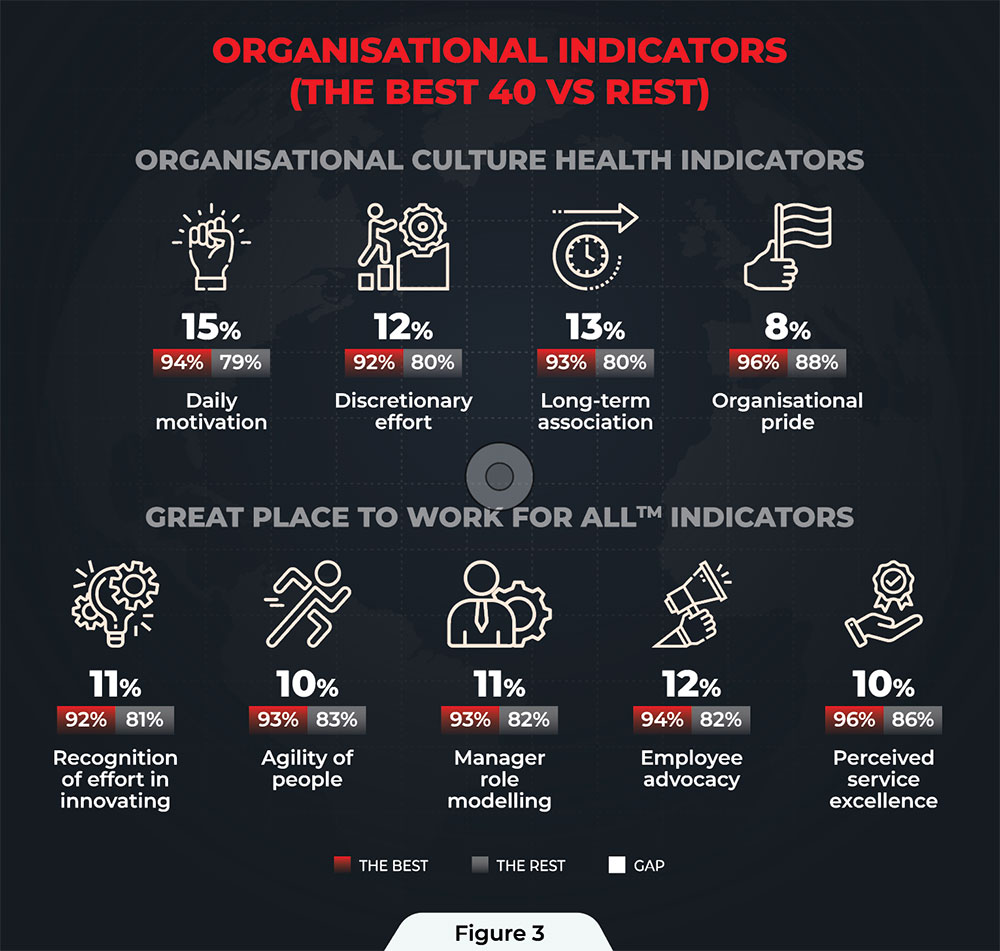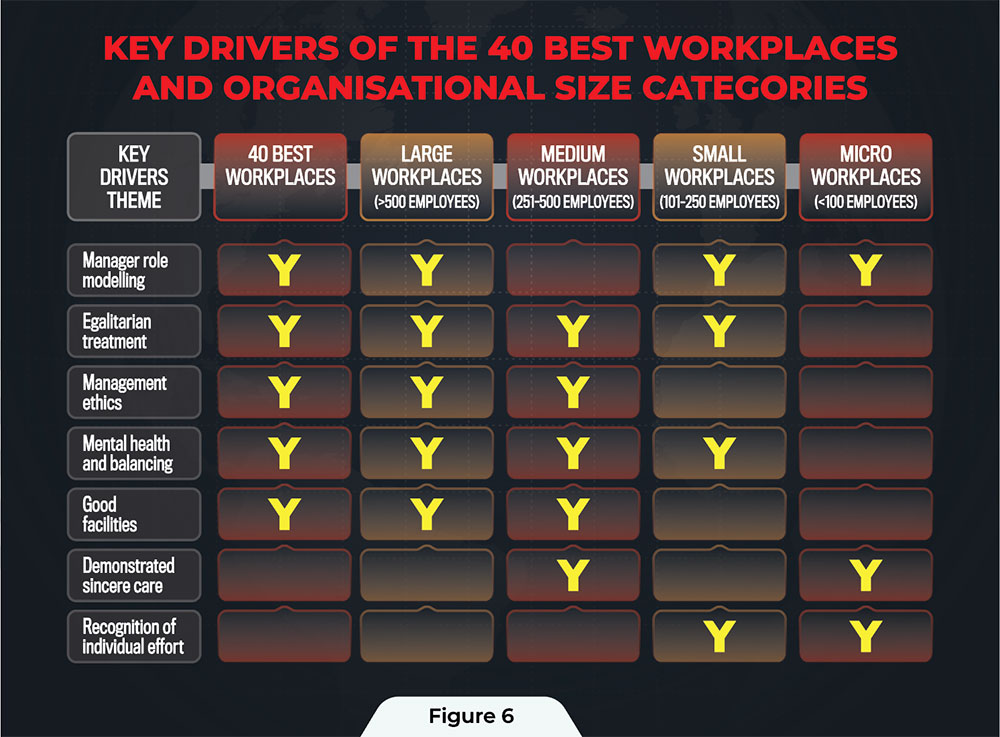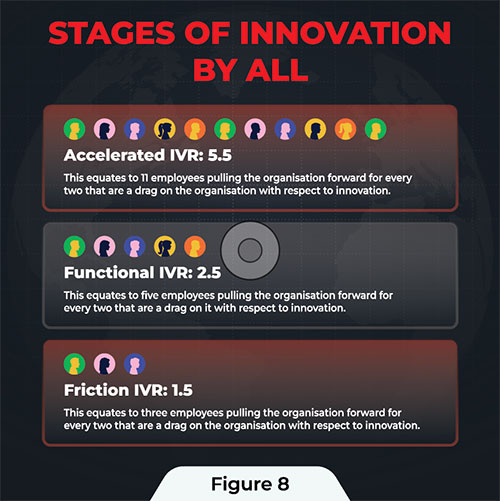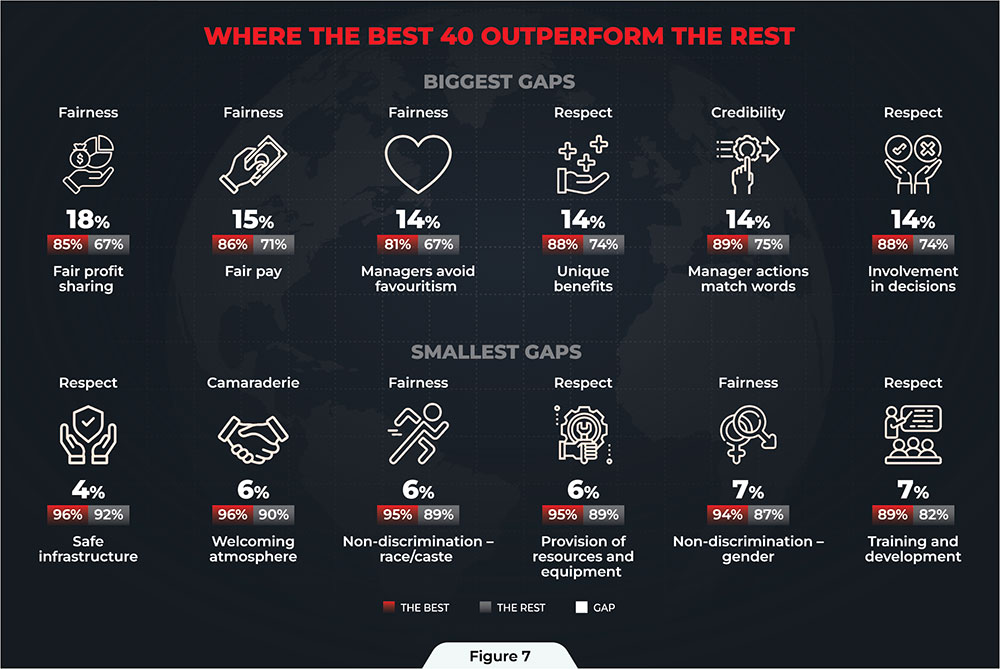
ASSESSMENT METHODOLOGY
Great Place To Work® Inc. is a pioneer that has been studying and recognising Best WorkplacesTM around the world for more than 30 years. It is located in over 90 countries and assesses organisations across 170 territories.
The Sri Lankan study is based on the global model and a rigorous methodology – it has been researched, evaluated and conducted in similar studies around the world.
This model applies across all geographies as it primarily measures the hygiene factors in the work environment, which are considered the requisite foundation of a Great Place To Work For All™. In turn, being a Great Place To Work For All is the basis for being selected as a best workplace.
Eighty-five percent of the Great Place To Work For All evaluation is based on the experience of trust and employees reaching their full human potential as part of their organisation, no matter who they are or what they do. These experiences are analysed in relation to each organisation’s size, workforce demographics and industry norms.
The remaining 15 percent of the evaluation is based on all employees’ daily experiences of innovation, the organisation’s values and the effectiveness of its leaders in ensuring they are consistently experienced.


THE FIRST STEP

The first step to being recognised as a great workplace is to voluntarily undertake a paid assessment with a view of measuring, being certified and opting to participate in the ‘Best Workplaces’ studies during the year of active certification.
While all organisations undertaking the Great Place To Work assessment can be certified for up to one year upon meeting global standards, participants who submit their information to the Best Workplaces study will additionally be considered for inclusion in the lists of the ‘Best Workplaces in Sri Lanka’ and ‘Best Workplaces in Asia’ each year.
To qualify for the national Best Workplacesstudy, an organisation must have 20 or more employees and be a registered entity in Sri Lanka.
TWO LENS MODEL

The Great Place To Work Modelconsiders workplace culture from two perspectives: the employee perspective – whereby the employees’ perceptions of the workplace experience are averaged using the Trust IndexTM survey; and the manager’s perspective –
whereby the quality of interactions intended through people practices established by the management is evaluated using the Culture AuditTM tool.
EMPLOYEE EXPERIENCE

A unique employee centric framework is used to measure employee perceptions through the Trust Index survey – a proprietary employee feedback tool developed by Great Place To Work.
Comprising 59 statements and using a five point Likert scale, the universal instrument measures employee experience and counts for 75 percent of an organisation’s score. A majority of the weightage is allocated to the actual experiences of employees, and gives them the power to validate or invalidate their organisations for this exclusive recognition.
The survey is available in all three local languages and administered in multiple modes – i.e. email, paper or kiosk, depending on the organisation’s requirements.
Through two open-ended questions, the tool also captures employees’ comments about what makes their workplace great and what would make it better. And it encourages employees to submit their opinions and suggestions through anonymous responses.
A robust procedure has been put in place to protect individual anonymity and the confidentiality of individual responses throughout the survey process. This will promote and enable honest and real feedback from employees.
PARTICIPATION

To be considered, organisations must meet the Great Place To Work CertifiedTM standard of minimum 70 percent positive employee sentiment and have an active certification (awarded for a maximum of one year) at the time of selection.
To ensure that survey results truly represent all employees, it is required that they be accurate to a 95 percent confidence level with a maximum five percent margin for error. For organisations that employ less than 5,000 people, all employees are selected to participate in the survey by default while larger organisations are assessed based on a random stratified sampling method.
EVALUATION

A strict methodology for maintaining anonymity is followed so that individual responses can’t be tracked by organisations that are participating in the survey.
A stringent audit process is implemented during and after completion of the survey to validate high scores. This provides employees with an opportunity to provide candid feedback on the organisation to maintain the assessment’s credibility.
MANAGER’S VIEW

The manager’s perspectives and practices established by management are measured by a proprietary tool and evaluation framework called the Culture Audit.
This is a comprehensive framework around which the organisation submits detailed information on the practices it has adopted to create a Great Place To Work For All. This submission is subject to rigorous evaluation by Great Place To Work trained evaluators.
The Culture Audit contributes to 25 percent of the overall score of an organisation. This instrument helps gauge not only an organisation’s structure and demographics, but also its philosophy and values – and how they are integrated into its people practices.
SIZE CATEGORISATIONS

Organisations were selected for the list of the 40 Best WorkplacesTM in Sri Lanka based on size categories.
This year, workplaces with 20-100 employees were considered in selecting the best 10 in the Micro category. Workplaces with 101-250 employees contributed to the best 10 in the Small category and workplaces with 251-500 employees contributed to the Best eight in the Medium category. Workplaces with over 500 employees were considered for best 12 in the Large category.
Organisations were ranked within the size categories on the list.
POST ASSESSMENT IMPROVEMENTS

To improve organisational culture following an assessment, the two lens model can relate employee feedback to identify practices that may not be effective.
This can be further studied through qualitative methods such as understanding root causes for priority areas using focus group discussions with employees as well as an onsite Culture Audit – a methodology comprising a series of discussions with employees, people managers and practice owners/HR, to understand the implementation and effectiveness of practices submitted.
Coupled with survey data, this can be used for action planning by the management team to improve perceptions and/or people practices in the organisation to create a better employee experience.
This ranking was finalised based on surveys conducted from April 2024 to March 2025.
SHAPING THE BLUEPRINT OF EXCEPTIONAL WORKPLACES
Great Place To Work looks to define the DNA of exceptional workplaces as it provides insights from its 2025 study
Picture a workplace where every employee feels valued, new ideas are welcomed and trust forms the foundation of success. This is the reality that the 40 Best Workplaces™ in Sri Lanka strive to create, even as the nation faces economic uncertainty and rapid change.
The Best Workplaces 2025 study brings this vision to life. Using the Great Place To Work For All methodology, the study reveals what sets these organisations apart and defines outstanding workplace culture. The findings reveal not only the strengths of the best 40 – such as high employee engagement, strong leadership and a culture of innovation – but also areas where the rest in the study can improve, including fair profit sharing, inclusivity and work-life balance.
In the context of Sri Lanka’s challenging economic conditions and ongoing transformation, measuring employee engagement and trust has never been more critical. Organisations that prioritise these factors are better equipped to remain resilient, attract and retain top talent, and drive sustainable success.
By examining key drivers and patterns of employee responses, the insights report by Great Place To Work in Sri Lanka underscores the importance of consistency in positive employee experiences, and the strategic value of fostering a supportive, equitable and engaging environment for all.
OVERVIEW This marks the 13th consecutive year of the study by Great Place To Work in Sri Lanka – contributing to the world’s largest ongoing workplace culture research.
From April 2024 to March this year, the local study surveyed over 78,000 employees across 130 assessments with an impressive average response rate of 89 percent, representing a workforce of 82,000 and 170 organisations spanning over 20 industries.
Using the globally standardised methodology, the study selected the 40 Best Workplaces for 2025 and set the current benchmark for excellence, and provided valuable insights into what defines a truly great workplace in Sri Lanka as its outcomes.
THE BIG PICTURE Figure 1 shows the average Trust Index™ score for Best Workplaces™ based on employee responses to 58 global statements and captures a comprehensive measure of the overall positive perception of their workplace.
In 2025, the Best 40 in Sri Lanka achieved an average 91 percent positive employee perception score with a majority of employees considering their organisation a great workplace. But the rest lagged by 11 points and revealed a notable gap.
Compared to Asia’s Best in 2024, Sri Lanka’s Best 40 scored one percentage point higher, indicating that Sri Lankan employees perceive their workplaces as exceptional and that their expectations are met. This highlights a strong commitment to trust, engagement and excellence.
FOCUS AREAS The Trust Index comprises five key focus areas that are the pillars of trust: credibility, respect, fairness, pride and camaraderie (Figure 2), which collectively shape the employee experience and determine workplace culture.
Pride takes the lead for the third consecutive year – employees at the best 40 continue to express a strong sense of pride in their organisations and teams, a sentiment that has improved compared to last year’s scores. This sense of pride reflects the deep connection employees feel toward their work and colleagues, and it drives engagement and loyalty.
However, yet again, the rest lag by 10 points, revealing a significant gap in how pride is experienced across different organisations. This disparity suggests the need for all organisations to focus on fostering a sense of purpose among employees to inspire reaching one’s full potential.
Fairness remains the lowest scoring area with a score of 89 percent with room for improvement. The rest trail behind by 12 points, emphasising the challenges some organisations face in ensuring equity and impartiality in the workplace. Transparency in decision making, equitable treatment across all levels, and the reinforcement of a culture rooted in fairness and inclusivity will help build greater engagement among employees.
Another key area is respect – employees at the best 40 report feeling respected and valued through demonstrated care, professional support and opportunities for collaboration. Such a positive environment enables employees to work cohesively, share ideas openly and build stronger interpersonal connections, which will ultimately drive organisational success.
In contrast, the rest lag by 11 points, indicating a noticeable gap in how respect is perceived. This disparity underscores the importance of creating a supportive workplace culture where employees feel appreciated and empowered to contribute their best.
ORGANISATIONAL CULTURE HEALTH INDICES The Trust Index acts as a compass for organisations by offering a comprehensive view of workplace culture and the factors that drive a thriving environment.
Figure 3 highlights key indicators of a great workplace within the Trust Index, showing the tangible benefits of investing in culture. The best consistently maintain a competitive edge over the rest, particularly in employee retention.
Employee perception around retention among the best 40 stands at an impressive 93 percent indicating an improvement compared to 2024. This score reflects confidence in organisations with many expressing that they envision themselves working for the long term.
When retention increases, organisations benefit from reduced recruitment and retraining costs, stronger institutional knowledge, and a more experienced, productive workforce – all of which contribute to sustained business success. In comparison, the rest lag by 13 points.
DEMOGRAPHICS While each organisation’s culture has its own distinct character, what truly sets a great workplace apart is the consistency of positive experiences shared by all employees.
In the 2025 study, the Great Place To Work For All methodology was applied to identify the best considering consistency of experience across gender, age, tenure and management role.
Notably, experience was greatly consistent on average across standard demographics with fluctuations higher among the rest. The standard patterns of past studies were observed with females, millennials (26 to 34 years) and mid-tenured employees of five to 15 years with lower perceptions among the rest.
What stood out the most among them was the lower positive perceptions around equity and impartiality in fairness. Among the best, Gen Zs and those with two years of service seemed to appreciate clear communication, manager competence, professional support and opportunities for collaboration.
INDUSTRY REPRESENTATION Among the industry representatives of the entire study, manufacturing and production emerged as the sector with the highest participation in Sri Lanka with 26 percent. It was followed by IT (17%), financial services (12%) and transportation (8%).
When it comes to being listed among the Best Workplaces, manufacturing once again leads the way with 38 percent. IT follows with 15 percent while financial services and transportation secure eight percent each – this highlights the varied industry presence among the best. Figure 4 gives a quick snapshot of the best 40 by industry.
SIZE CATEGORISATION The Trust Index applies to organisations of all sizes – however, managing employee perceptions becomes increasingly complex as workforce size grows.
Figure 5 illustrates how perceptions vary across the four organisational size categories assessed this year; it reveals a consistent trend: employee perceptions tend to decline as organisation size increases.
Notably, there is a significant dip in perceptions within medium-size organisations (251-500 employees), which stand out from the broader pattern. This data underscores the correlation between workforce size and average employee perceptions.
The debate remains ongoing with advantages and disadvantages at both ends of the spectrum – larger organisations that are equipped with greater resources can offer employees a wider range of options. However, smaller organisations may achieve higher levels of employee engagement by fostering closer connections and placing greater value on individual voices.
KEY DRIVERS Key drivers are the factors strongly associated with an employee’s emotional connection to the workplace. While these drivers can shift over time and vary between organisations, certain common themes consistently emerge regardless of size.
Figure 6 highlights the most significant drivers among the best 40 – manager role modelling, egalitarian treatment and management ethics.
Manager role modelling is where employees feel that the management truly embodies the organisation’s core values. Egalitarian treatment is where every employee feels respected and valued.
Both are crucial across most organisational size categories. Micro organisations also stand out for their ability to recognise individual contributions, which often drive innovation.
THE BEST VERSUS THE REST
STRENGTHS Pride – particularly in the organisation’s image and team’s achievements – stands out as a strength with a score of 93 percent. Hospitality is another notable area with employees feeling a strong sense of welcome when joining the organisation, as reflected in an impressive 96 percent positivity among the best.
Additionally, good facilities emerge as a strength – not necessarily in terms of luxurious offices but in providing employees with the tools and resources they need to excel in their roles. Efficient systems and timesaving tools enable employees to focus on delivering exceptional results, further boosting productivity and engagement.
KEY DIFFERENTIATORS The best 40 distinguish themselves from the rest through key differentiators across several areas as illustrated in Figure 7. The most striking contrast is in perceptions of fair profit sharing, where the rest lag behind by a notable 18 point margin and highlight a clear opportunity for improvement.
This matters because fair profit sharing creates a win-win scenario. When employees recognise that their contributions lead to shared success, it fosters a sense of ownership and motivates them to align with the organisation’s goals, knowing that they too will benefit from its achievements.
EFFECTIVE LEADERSHIP Perceived leadership effectiveness is shaped by factors such as managers’ approachability, business acumen, clarity of vision and genuine concern for employees.
The survey results indicate that business acumen has remained stable since 2024 with the rest continuing to trail the best by an eight point gap. Although this gap has not narrowed, it remains a consistent area for improvement.
On a more positive note, the demonstration of sincere care – while still the lowest scoring area – reflects a slight improvement since last year. In this regard, the rest lags behind by 12 points, underscoring progress made and the continued need for development opportunities.
CONFIDENCE DISPARITY When it comes to confidence in management’s judgement, the difference is striking. Among the best, 67 percent of employees report having a ‘great deal’ of trust, compared to merely 46 percent among the rest. This considerable gap underscores the critical role that strong and credible leadership plays in fostering trust within the best.
Addressing this gap may involve enhancing communications, increasing transparency in decision making, and promoting greater collaboration between management and employees.
INNOVATION BY ALL Innovation thrives when every employee – regardless of his or her role – is empowered to contribute fresh ideas and improvements. Survey data reveals that 60 percent of employees in the best report having had many opportunities to innovate last year, compared to 39 percent among the rest.
This highlights a clear trend: organisations that encourage innovation at all levels consistently outperform those where creativity is confined to a select few. High trust environments make employees feel safe to share ideas, take risks and learn from mistakes, thereby driving continuous improvement and agility.
Great Place To Work research further illustrates this through the Innovation Velocity Ratio (IVR) (Figure 8), which measures how many employees feel empowered to innovate.
The best 40 achieved an average IVR of five, reflecting a robust culture of innovation by all, while the rest averaged at two, indicating greater friction and barriers. These findings reinforce that ‘innovation by all’ is not merely a cultural asset but is instead, a strategic imperative for long-term success.
AREAS FOR IMPROVEMENT In thriving organisations, achieving excellence is a continuous journey that involves recognising areas for improvement.
Even among the best, performance management – despite an 84 percent positivity score – emerges as an area to address.
While promotions are intended to reward merit, there is a perception that opportunities don’t always reach the most deserving individuals. If left unaddressed, this could gradually erode the organisation’s culture of fairness and recognition. Workplace politics and backstabbing are also noted as concerns that can undermine trust and collaboration, if not proactively managed.
Compensation is another area where both groups see room for improvement in Sri Lanka.
Among the best, perceptions of fair profit sharing scored 85 percent while the rest reported a significantly lower score (67%). Similarly, fair pay is an area of concern for the rest, scoring 71 percent. These figures highlight a need for greater focus on equity and recognition within compensation practices.
Work-life balance is another improvement area for the best with 88 percent positivity.
Strengthening supportive policies and systems to maintain a healthy work-life balance is vital for sustaining engagement and preventing burnout. This will ultimately enable employees to demonstrate greater commitment and performance.
For the rest, the desire for improvement goes beyond compensation. Many employees expressed the need for a more enjoyable and engaging work environment, as reflected in the 76 percent score for fun at work. Introducing creative breaks and on-the-job team building activities can help create camaraderie, and make the workplace more enjoyable for all.
LAST WORDS In today’s rapidly evolving environment, being the best requires intentional efforts and a commitment to continuous improvement. The insights from the Sri Lanka Best Workplaces 2025 study offer organisations a clear data backed understanding of the prevailing workplace landscape.
By leveraging these findings, leaders can make informed decisions to strengthen their culture, address areas for improvement, and foster environments where employees feel valued, engaged and empowered.
Measuring and acting on employee experiences is not simply a benchmark of excellence; it’s a strategic imperative for organisations that are aiming to thrive and lead in Sri Lanka’s dynamic context. The time is right for organisations to use these insights as a road map for building better and more resilient workplaces for all.
Great Place To Work’s mission is to help every workplace become a Great Place To Work For All so that organisations can maximise human potential through a High-Trust High-Performance Culture™ that drives business, improves lives and creates a better society.
No matter where you are in your journey, you’re invited to join and contribute to achieving the vision of making Sri Lanka a great place to work.
– Compiled by Great Place To Work in Sri Lanka Best Workplaces
FOOTNOTE For more information on how to begin your journey of becoming great, contact Best Workplaces List Manager Ruwani Alwishewa (0766 301200 and lk_support@gptw.com, call 4545594 or visit www.greatplacetowork.lk).
CATEGORY AWARDS
The Great Place To Work® category awards celebrate organisations that showcase excellence in areas related to the Great Place To Work For All™ model, and essentially cultivate an overwhelmingly positive and consistent work experience for employees by sustaining a High-Trust High-Performance Culture™.
Organisations that best display the criteria are recognised under four award clusters: Excellence in People Initiatives (two selected practices), the Cube Award for Special Recognition, Organisation Size and Classification, and Legends (organisations listed for five and 10 years in a row).
EXCELLENCE IN PEOPLE INITIATIVES
Great Place To Work in Sri Lanka considers the Excellence in People Initiatives recognition as an opportunity to build awareness and encourage best practices that support building and maintaining a great workplace culture.
Winners in these categories score high in the submission highlighting people practices (two-thirds of the final score) as well as their respective employee perception scores (a third of the final score).
The Great Place To Work For All model has categorised six key areas that an organisation’s management must focus on to create an impactful and consistent employee experience across the workplace that engages them and offers the organisation a competitive advantage over its peers.
For the record, the two practices selected for this year’s awards are for excellence in ‘leadership effectiveness’ and ‘maximising human potential.’
EXCELLENCE IN LEADERSHIP EFFECTIVENESS
The manner in which employees experience their workplace is shaped by their interactions with people managers.
Effective leaders should not only connect emotionally with the organisation’s culture and its employees, but also be capable of developing a clear and impactful strategy across all levels of the business.
The award for Excellence in Leadership Effectiveness is presented to an organisation that has demonstrated strong leadership through effective manager behaviours and people centred practices.
This includes fostering employee confidence in the competence and vision of the leadership, promoting a collaborative approach to shaping and communicating both short and long-term business strategies, and encouraging leaders to be approachable and sincere in building positive relationships with employees.
Supporting evidence may include communication channels that effectively distribute information across the organisation with a feedback loop, key performance indicators that track both individual and organisational progress, and development programmes that enhance managers’ ability to lead teams effectively.
EXCELLENCE IN MAXIMISING HUMAN POTENTIAL
The best workplaces consistently foster high trust experiences across diverse employee groups by positioning them to unlock the full potential of their workforce.
This enhances business performance, ensures long-term sustainability, and drives innovation by inspiring employees to deliver their personal best while drawing on a wide range of ideas and unique talents.
Creating a sense of belonging begins with inclusive people practices. It’s essential to provide systematic support and tailored benefits for specific employee groups such as those defined by gender, race or ability, and promote equity and empower individuals to reach their full potential.
The Excellence in Maximising Human Potential award recognises organisations where employees experience a high level of consistency in their positive workplace experiences. And the winning organisation should demonstrate people practices that promote equity in hiring, performance management, rewards and promotions while also showcasing how they harness unique talents through development programmes.
Additionally, they should have well-established DEI initiatives across diverse groups that cultivate a culture of care, inclusive leadership and awareness. Success can be demonstrated through examples, stories and impact metrics that highlight how these initiatives have benefitted both individuals and the organisation.
CUBE AWARD
FOR SPECIAL RECOGNITION
BEST IN Bold Acts of Leadership/Movement Leadership
The best workplaces have a vision to go beyond simply achieving business performance, and focus on long-term sustainability and having meaningful impacts on the community.
This year’s study continued to collect information around bold acts of leadership made by organisations to create a Great Place To Work For All™ environment for employees and the community.
Movement leadership begins with leaders working towards a profitable business that champions a higher purpose such as driving meaningful change in the world. And the Best in Bold Acts of Leadership/Movement Leadership award recognises these achievements.
Initiatives in this area should have a clearly defined scope, substantial resource investment, measurable impact with tangible results and documented stakeholder engagement, which demonstrate a genuine commitment to the organisation’s cause.
Aligning these programmes with the organisation’s vision and mission fosters a deeper connection among employees, and inspires them to engage more meaningfully with the workplace.
CATEGORY AWARDS
BY ORGANISATIONAL SIZE AND CLASSIFICATION
ORGANISATION SIZE (EMPLOYEE STRENGTH)
Maintaining an inclusive and thriving workplace culture becomes increasingly complex as the workplace grows, presenting unique challenges at different organisational scales.
To ensure fair comparison, the organisations among the best 40 were selected and ranked within their respective employee strength category (10 micro organisations of 20-100 employees, 10 small organisations of 101-250 employees, eight medium-size organisations of 251-500 employees and 12 large organisations with over 500 employees). The top three in each size category are honoured as the gold, silver and bronze winners.
ORGANISATION CLASSIFICATION
This includes the top multinational corporations (MNCs) and listed companies (PLCs) in Sri Lanka. The leading MNC and PLC are selected based on the highest combined score in terms of employee perceptions through the Trust Index™ survey and people practices within the Culture Audit™.
LEGEND STATUS
Building and enduring as a great workplace is a journey that requires continuous dedication to a meaningful cause.
Organisations that have proved their commitment to furthering employee engagement and people management by gaining a place on the Best Workplaces list for five and 10 consecutive years are recognised as Five Year Legends and Ten Year Legends respectively, and inducted into the Hall of Fame.
Hilton Sri Lanka and the Unidil Group of Companies join the list of Five Year Legends this year.
And Advantis Express – Licensee of Federal Express joins AIA Insurance Lanka, DIMO, DHL (Keells) and Oxford College of Business as a Ten Year Legend in Sri Lanka’s Hall of Fame.
BEST WORKPLACES IN ASIA
The Great Place To Work® annual study of Asia’s Best Workplaces™ celebrates Best Workplaces™ across the Asia-Pacific and Middle East. The regional list distinguishes organisations under three size categories: Best Multinational Workplaces in Asia (over 1,000 employees with more than 40 percent of the workforce outside the headquartered country and with listings across three countries in the region), Best Large Workplaces in Asia (500 employees or more), and Best Small and Medium Workplaces (less than 500 employees) in Asia.
This list considers results from the Sri Lanka study conducted from April 2024 to April 2025. It will be released on 28 August 2025.
FOOTNOTE Winners for category awards will be announced at the Great Place To Work Sri Lanka Best Workplaces Gala Awards Ceremony in September 2025.

